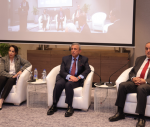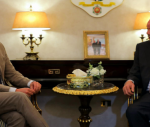You are here
Jerusalem, sanctuary for all
Nov 12,2014 - Last updated at Nov 12,2014
What is to be done about Jerusalem?
Twenty five years after the fall of the Berlin Wall, this region is witnessing new walls being constructed in vain attempts to contain problems between people.
When will we realise that walls separating cultures and people exacerbate sectarianism and accelerate fragmentation?
How long will walls, figurative and physical, continue to poison our humanity?
The escalating tensions in the Old City of Jerusalem, ostensibly unified but actually never more divided, compound the debris left by the military campaigns of the past decades.
These events typify this conflict as one not being played out in the courtrooms of a state, the international community, or even the ethical courtrooms in our minds,
This is a conflict that uses instruments of aggression aimed at polarising an already fragmented population. It causes us to wonder for how long we will allow holy spaces to be used as tools of war.
Competing claims to Jerusalem as the capital for both Israel and a future Palestine reflect the need for a new architecture of waging comprehensive peace, where the cultural universal domain rises above the geo-politics to become a template of hope.
A walk through Jerusalem is a tour of world religion, architectural ascendancy and the winners and losers of war.
The first stop is the Church of the Holy Sepulchre, to Christians the site of Jesus’ crucifixion, burial and resurrection, and the holiest place for Catholic and Orthodox Christians.
It holds a legacy of demolition; its construction required the destruction of the Roman temple of Venus; the Persians destroyed the church in 614, in 638 the basilica entrance was converted into a mosque, then in 966, it was again destroyed during anti-Christian riots.
Next is the Temple Mount, the holiest site in Judaism, the first qiblah in prayer for Islam and third most holy site in Islam.
According to the Bible, the first temple was destroyed by Babylonian forces in 586 BC. It was rebuilt, but destroyed again by the Romans in 70 AD. After the Muslim conquest of Jerusalem in 637, the Dome of the Rock and the Al Aqsa Mosque were built at the site as Muslim shrines.
The stone in the Haram Al Sharif, enclosing over 144,000 square metres of fountains, mihrabs, chambers, schools, gardens, buildings and domes, is believed to mark the place where the Prophet Mohammad ascended.
In Judaism, it is where Abraham offered Isaac, and the location of the temple.
The visitor might ponder what cultural openness facilitated such a geographically contained flourishing of religious spirit.
That same visitor might draw inspiration from hearing the Muslim call to prayer punctuated by church bells, and two groups praying at one wall to one God of different traditions.
In a momentary lapse of consciousness, one might confuse Jerusalem with a place that epitomises tolerance and plurality.
But of course we know that this metaphor is an illusion. The loss of trust negates the will to manage this shared heritage.
The controversy over the management of the holy spaces is deep, but ironically has little to do with religion.
While the site remains within the security control of Israel since its occupation of East Jerusalem in 1967, administration has been vested in an Islamic waqf since 1187.
Jerusalem’s long history demonstrates that occupation is futile.
Israel and its neighbours are legally bound to recognise the status quo ante 1947. Instead of which, the absence of the shared management in good faith of the holy space has triggered violence for decades.
Have we not recognised that these clashes are not about religion? They are about politics.
All sides should declare this deadlock and unify under the argument that the politicisation of holy space crosses an ethical and moral line.
Holy places must be governed by the adherence of inter-faith, and if this is not possible, they must be governed by international law and ecumenical values.
When will the three Abrahamic religions be encouraged to work together to craft a solution that takes our common identity as the basis for our shared humanity?
Only through the humanisation of humanitarian law and the adherence to a culture of mutual respect, can we get to a point where Holy Jerusalem may be shared equally and allowed to flourish.
As my good friend Kenneth Cragg reflected, in our joint stewardship of the holy domain we share a sacred trust; our responsibility to faith is a relatively simple task for a believer, but if our fidelity does not want to be a mere “faith in faith”, we have to take responsibility for faith.
Until we take this seriously, promoting peace, liberty and social justice in the Holy Land will remain an aspiration.
The writer is chairman of the West Asia North Africa Institute. He contributed this article to The Jordan Times.













